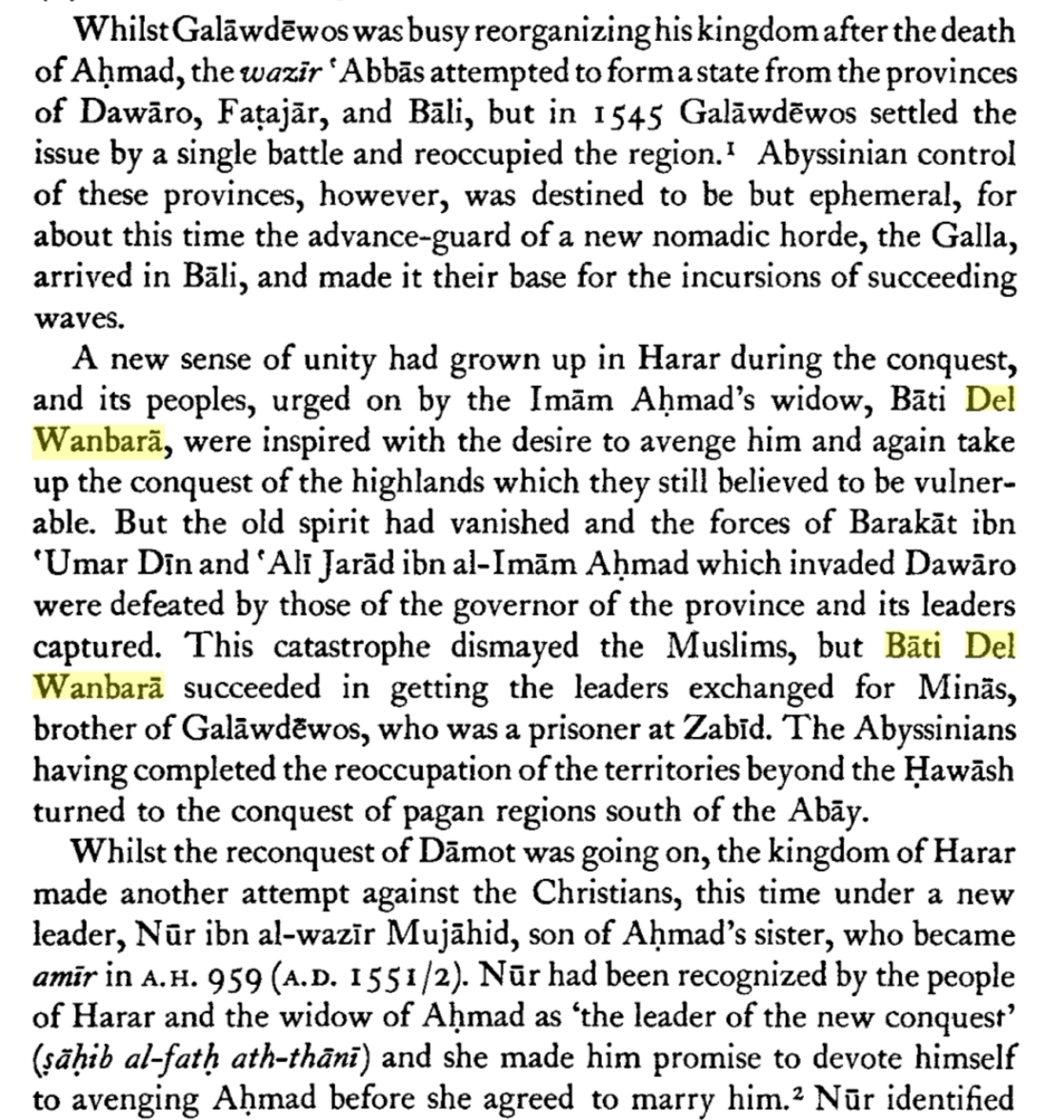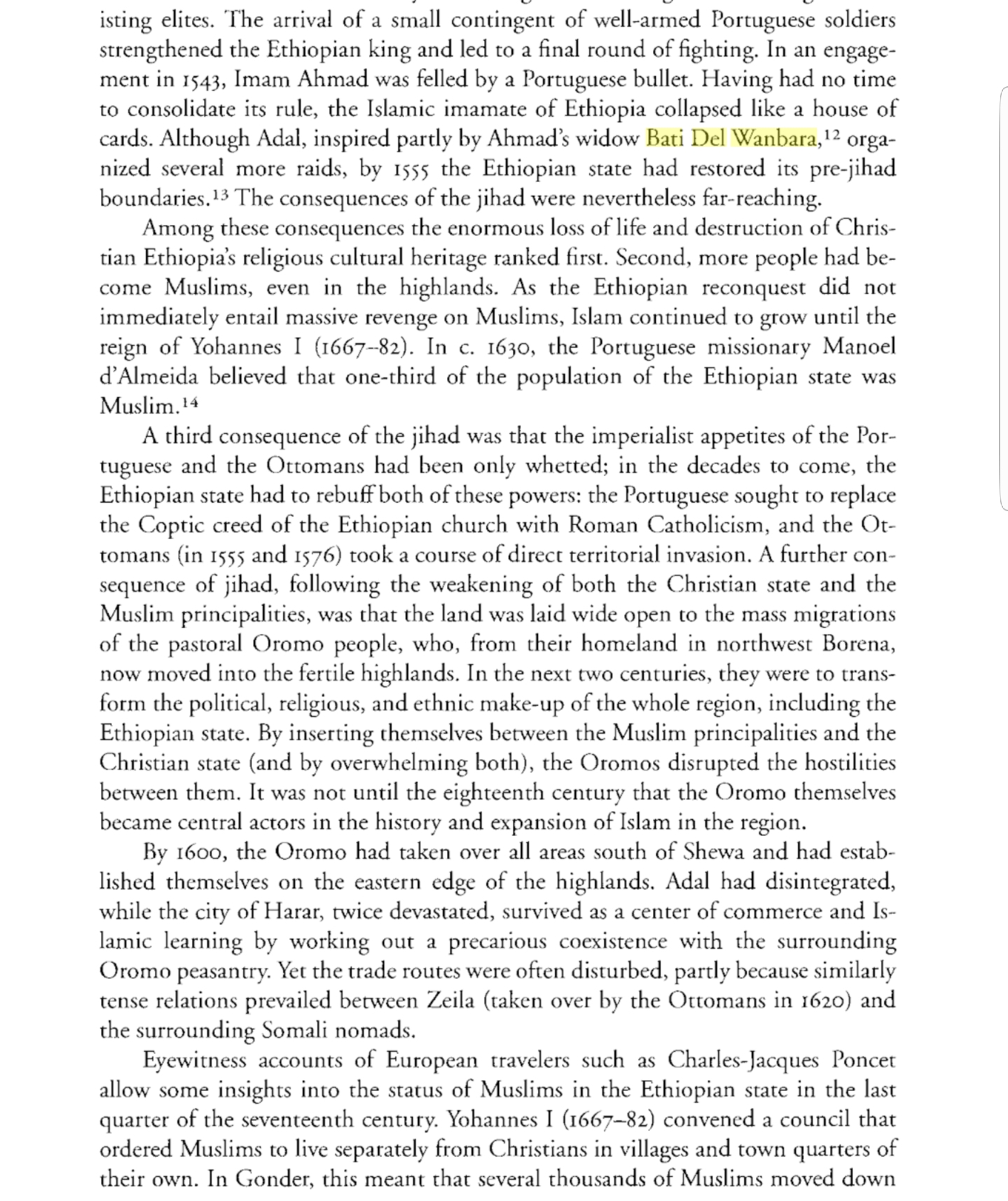https://en.m.wikipedia.org/wiki/Bati_del_Wambara
The Portuguese expedition to Abyssinia in 1541-1543 as narrated by Castanhoso

Women and Warfare in Ethiopia
Bati del Wambara (Harari: ባቲ ዲል ወምባራ, fl. 1531, literally Victory is her seat)[1] was the Harari[2]daughter of Mahfuz, Emir of Harar in Ethiopia and later Governor of Zeila. She married Imam Ahmad ibn Ibrahim al-Ghazi and accompanied him in his jihad[3]to make Ethiopia a Muslim province.[1] During this expedition, she gave birth to two sons - Muhammad in 1531 and Ahmad in 1533.[1]
After Imam ibn Ibrahim's death, she married the successive Emir of Adal, Nur ibn Mujahid. This was a political marriage aiming to enforce Nur's legitimacy. She is supposed to have pushed him into reviving the jihad in order to avenge the death of the Imam Ahmad ibn Ibrahim[4]
The Portuguese expedition to Abyssinia in 1541-1543 as narrated by Castanhoso
He married a remarkable woman, the second of the three notable women (Queen Helena being the first, and Ite Sabla Wangel, wife of Lebna Dengcl, the third), that figure in this history; she was Bati Del Wanbara, a daughter of Mahfuz, the well-known Emir of Harar, slain in single combat by the monk Gabriel Andreas in 1517. Del Wanbara was the constant companion of her husband in his raids in Abyssinia, but she was more than a mere companion: her influence was frequently exercised on the side of mercy; so notorious was this, that even the Abyssinian chronicles, bitterly opposed as their writers were to her husband as the deadliest foe of Christianity, loudly praise her humanity. In 1539 the Muhamedans captured Minas, the fourth son of Lebna Dengel (Emperor of Abyssinia), and his two cousins; both the cousins were made eunuchs, but by the intercession of Del Wanbara, Minas was not only saved from this fate, but even married to her daughter: a unique instance of clemency. Minas was, however, subsequently utilised by his father-in-law, who sent him across to Zebid (Yemeni city) as a present to the Pasha (Ottoman general), when the early victories of D. Christovcio (de Gama) showed the necessity for reinforcements. At the battle of Wainadega, in February, 1543, when the Imam Ahmad was killed, Muhamad, his and Del Wanbara's eldest son, born in 1531, was captured. Through the influence of the two mothers, Del Wanbara and Sabla Waiigel, an exchange of prisoners was effected, Muhamad being restored to the Muhamedans and Minas to the Christians. Minas lived to succeed his brother Geliwdewos as ruler of Abyssinia. But Del Wanbara's share in events was not ended with the death of the Imam Ahmad. She was sought in. marriage by his successor, Nur, the son of Mujahid, and she made it a condition of her consent that Nur should revenge on Galiwdewos the death of her first husband, the Imam Ahmad. Nur was eventually successful, and killed Galiwdewos in battle, in 1559.
How the prisoner exchange was conductedThe escape of Minas from emasculation was almost unprecedented; of course he turned Muhamedan temporarily. Del Wanbara was not always submissive to her husband, for she refused to leave him when all the army resented as an innovation her accompanying him on the Abyssinian raids. But her presence was not very obnoxious, for the soldiers soon after voted her a large share of
the booty; it was refused as a private gift, however, but set aside as a
war fund, and weapons purchased.
Bati del Wambara's brotherThis Prince did not long remain a prisoner. At the insistence of Del Wanbara and Sabla Wangel, the two mothers, an exchange was effected between this man and Minas, brother of Galawdewos (and his two cousins thrown in), who had been captured on May 19th, 1539. The exchange was made with some ceremony at sea, off Massowa, either side arriving in its own boat.
Nur Mujahid's fatherThe Emir Mahfur had a son, Garad Ahmadouch, one of Imam
Ahmad's trusted lieutenants, as well as this daughter.
Islam in EthiopiaMujahid was in command at the capture of Amba Geshen, and killed all the royal princes confined there.

Women and Warfare in Ethiopia
Contemporary to Seble Wongel in the Muslim camp was a renowned woman of courage, Bati Del Wanbara, who was the wife of Ahmed Gragn and daughter of a Muslim military commander of Adal known as Mahfuz. Her father had been one of the Adali leaders of the constant frontier attacks against the Christian kingdom until his death in one of the campaigns in 1516. Tradition claimed that Del Wanbara had instigated her husband to avenge the death of her father. Be that as it may, she accompanied her husband throughout his expeditions despite the protestation of his soldiers. At times she had to be carried on the shoulder of soldiers up and down steep and rocky mountains. This was because she is said to have marched even in a state of pregnancy during which she was unable to use mules. Indeed she delivered her two sons during the campaigns of 1531 and 1533 in Ifat and Tigre, respectively (Tekle Tsadiq 1961 E.C., 95).
Like the camp of the Christians there were also other Muslim women along with the wife of Ahmed. They were mainly wives of military commanders and soldiers. One of them was an ex-Christian wife of a certain Tekle Haymanot and was the relative of King Lebne Dingil before she was captured in battle and became wife of Ahmed, taking the name Hajirah. The sister of Ahmed known as Ferdausah, who was married to a Somali tribal leader Ben Uthman (Ibid) too participated in the major battle of Shimbra Kurie in 1529 at which the Christian army under king Lebne Dingil was completely defeated. Even though we lack sources of their engagement in actual combat the Muslim women too had been playing the role of nursing the wounded and building the morale of fighters.
Del Wanbara was, however, more important in instigating war even after the defeat of the Muslims in 1543. At the death of her husband, Del Wanbara fled to Harar and made a last bid for revenge. Before that, she secured the return of her son, who was a captive in the Christian court; she secured his liberty in exchange for another captive in her hand known as Minas, son of Lebne Dingil and an emperor of Ethiopia between 1559 to 1563. Obviously, Del Wanbara and Seble Wongel were instrumental in the exchange of the captives who were in fact their sons. Del Wanbara, however, did not give up her role of instigating her menfolk to a revengeful war. In 1552 she married Emir Nur Ibn Mujadid, successor of Ahmed, seeing in him the best prospect of achieving her aim of avenging the death of Ahmed. Indeed in 1559 a battle was fought between Ibn Nur and Emperor Gelawdewos in Fatagar, at which the latter was killed and beheaded by the order of Del Wanbera according to some sources (Ibid, 78; Sweetman 1984, 29; Doresse 1967, 147) Consequently both Seble Wongel and Del Wanbara made an immense contribution in changing the course of events in the 16th century.












